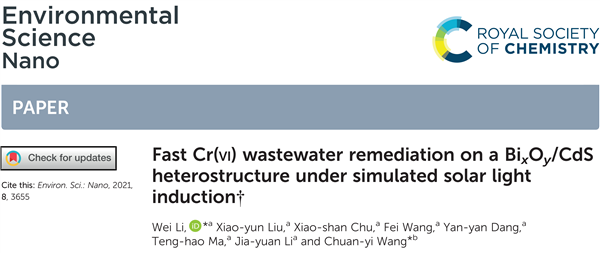Fast Cr(VI) wastewater remediation on a BixOy/CdS heterostructure under simulated solar light induction
writer:W. Li,* X. Liu, X. Chu, F. Wang, Y. Dang, T. Ma, J. Li, C. Wang
keywords:Chromium-containing wastewater, Bismuth oxide, Heterostructure, Cadmium sulfide, Photoreduction
source:期刊
specific source:https://doi.org/10.1039/D1EN00801C
Issue time:2021年

Bismuth oxide (BixOy), an important bismuth based semiconductor with visible-light response, good structural stability and non-toxic, is identified as a potential candidate for chromium (Cr(VI))-containing wastewater remediation. However, the poor broadband light response and easy electron-hole recombination generally lead to unfavorable catalytic activity. Constructing heterostructure is demonstrated to be an effective strategy for improving the catalytic performance of BixOy-based photocatalyst due to the improved photoresponse and promoted interfacial carriers mobility. Herein, CdS nanoparticles with low work function and good visible-light response were chosen as the cocatalyst to construct the p-n type BixOy/CdS heterostructure via a solvothermal method. Due to the formation of typical II-type induced mechanism, the interfacial carriers mobility and broadband light response were effectively improved, thereby the remarkably enhanced simulated solar-light (SSL)-induced aqueous Cr(VI) reduction activity (0.1265 min-1) was achieved by the optimum BixOy/CdS catalyst at the absence of scavenger, which is ~34.2-fold greater of pristine BixOy (3.7×10-3 min-1) and possesses distinct advantage compared with literatures. Also, the promoted carriers transfer effectively suppresses the photo-corrosion of CdS microstructure, resulting the desirable photostability under long-term photoinduction. This study provides a feasible strategy to aqueous Cr(VI) pollution remediation.